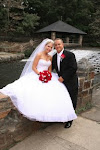
This photo is a close up of a blueberry. Using Macro diopters on the front of my lens, I arranged various nuts around the berry. The nuts are earthy tones, warm tones while the blueberry stands cool and dark in contrast.
I saturated the blueberry with Photoshop to give it a bluer appearance.
Special note: When you do close-up photography the same rules apply as if you were doing a full-size still life. Note the rule of thirds applied, the foreground framing and the background design which balances the composition and leads the eyes to the subject.
Back light is used for lighting with a silver reflector adding foreground fill


